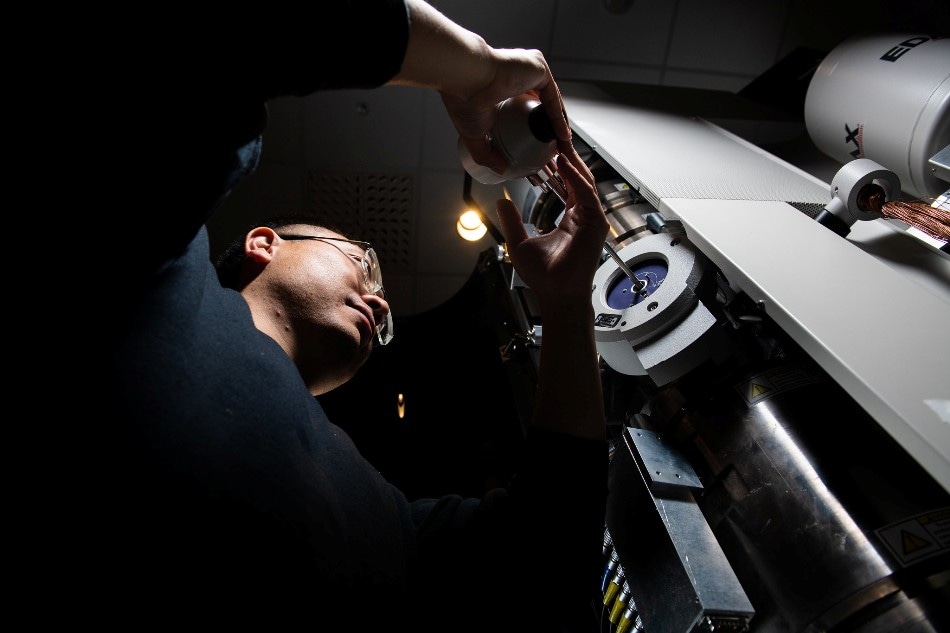Oct 15 2019
Researchers have discovered the reason for the growth of needle-like structures—called whiskers and dendrites—that degrade lithium batteries, occasionally causing failure, a short circuit, or even a fire.
 Researcher Yang He adds a sample to the environmental transmission electron microscope. (Image credit: Pacific Northwest National Laboratory)
Researcher Yang He adds a sample to the environmental transmission electron microscope. (Image credit: Pacific Northwest National Laboratory)
The researchers, under the leadership of Chongmin Wang from the Department of Energy’s Pacific Northwest National Laboratory, have demonstrated that the occurrence of specific compounds in the electrolyte—the liquid material that renders the critical chemistry of a battery possible—leads to the growth of whiskers and dendrites.
They believe their findings would pave the way for new methods to hinder their growth by manipulating the ingredients of the battery. The findings were published online in Nature Nanotechnology on October 14th, 2019.
Dendrites are small, rigid tree-like structures that are capable of growing within a lithium battery; their needle-like projections are known as whiskers. Both lead to huge damage; specifically, they can penetrate into the separator within a battery, quite similar to a weed that pokes through a paved road or a concrete patio.
They also increase undesirable reactions between the lithium and the electrolyte, accelerating the rate of battery failure. Dendrites and whiskers have hampered the extensive use of lithium metal batteries, which possess higher energy density compared to their often-used lithium-ion equivalents.
The PNNL researchers discovered that the root cause of whiskers in a lithium metal battery is a structure called the solid-electrolyte interphase (SEI). It is a film where the solid lithium surface of the anode makes contact with the liquid electrolyte.
Moreover, the team found that ethylene carbonate, an essential solvent added to the electrolyte to improve the performance of the battery, was the real culprit in the growth process that subjects the battery to damage.
Catching Fast-Moving Action Inside Lithium Batteries
The study results include videos that demonstrate the step-by-step growth of a whisker within a nano-sized lithium metal battery primarily designed for this research.
A dendrite appears as lithium ions begin to “nucleate,” or clump, on the anode surface, developing a particle that indicates the rise of a dendrite. This gradually grows as greater numbers of lithium atoms group together, growing in a fashion similar to a stalagmite from the floor of a cave.
The researchers discovered that the energy dynamics on the SEI surface force more lithium ions into the gradually growing column. Subsequently, a whisker quickly emerges.
It was difficult for the researchers to capture the action. They achieved this by combining an atomic force microscope (AFM) and an environmental transmission electron microscope (ETEM), a high-cost instrument that can help study an operating battery in real time.
The AFM was used to estimate the small force of the whisker as it developed. Similar to a doctor measuring the strength of a patient’s hand by asking him or her to push upward against the doctor’s stretching hands, the researchers estimated the force of the growing whisker by pushing down the cantilever of the AFM on its tip and evaluating the force exerted by the dendrite during its growth.
The Recipe for Electrolyte
The researchers discovered that the ethylene carbonate level is directly associated with the growth of whisker and dendrite. With the increase in the material put into the electrolyte, the growth of whiskers increased.
The researchers experimented with the electrolyte mixture, varying ingredients so that dendrites will reduce. Few changes, like the addition of cyclohexanone, hindered the dendrite and whisker growth.
We don’t want to simply suppress the growth of dendrites; we want to get to the root cause and eliminate them. We drew upon the expertise of our colleagues who have expertise in electrochemistry. My hope is that our findings will spur the community to look at this problem in new ways. Clearly, more research is needed.
Chongmin Wang, Study Corresponding Author, Pacific Northwest National Laboratory
Wu Xu is the other corresponding author of this study. Yang He, the first author of the study, added that if the causes for the origin of whiskers and their growth are known, then new ways for eliminating them or at least controlling them to reduce damage can be facilitated.
He and the team monitored the reaction of the whiskers to a barrier, by buckling, kinking, yielding, or stopping. Better insights can open up ways for the wide application of lithium metal batteries in laptops, electric cars, mobile phones, and other fields.
Authors of the study, from EMSL and PNNL, include Wang, Xu, and He, as well as Xiaodi Ren, Yaobin Xu, Mark Engelhard, Xiaolin Li, Jie Xiao, Jun Liu, and Ji-Guang (Jason) Zhang. The study was financially supported by DOE’s Office of Energy Efficiency and Renewable Energy’s Vehicle Technologies Office.
The study was made possible due to the unique combination of capabilities available at EMSL, the Environmental Molecular Sciences Laboratory, a DOE Office of Science user facility situated at PNNL.
Watching Whiskers Grow inside Lithium Batteries
Video credit: Pacific Northwest National Laboratory.